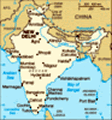Advertisement
Published: March 27th 2011
(Day 1078 on the road)A long time ago, I made a list of 50 places in the world I wanted to try and visit during my life. I have already managed to see a fair bit of these, but not yet the lesser-known backwaters of Kerala. Together with better-known places like the pyramids in Egypt, Angkor Wat in Cambodia or indeed the Taj Mahal here in India, Kerala has always been on that list. Not surprisingly, I was very excited when we were finally entering Kerala on yet another overnight train from Goa – and I was not to be disappointed!
Kerala's interior is criss-crossed by a network of 900km or so of canals, rivers and lakes, where often the only means of transport for the people living here is by boat. Thus, the life of the people here is very much dominated by the water that surrounds them. For the tourist, drifting through these waters, be it on a rented houseboat or on more local boats and ferries, it offers a unique glimpse into how these people live. It often seems very much unchanged from how they must have lived for decades in the past, and it was truly
fascinating to witness.
We arrived in Kerala – promoted as "God's own country" by the tourism board but actually meaning just "land of coconut" - in the port city of Kochin, famous for its giant Chinese fisher nets, which are to this date lowered and raised into and from the water by the sheer muscle power of its operators. We found a nice little hotel with super-friendly owners and started making plans for the coming days.
After getting our bearings for a day we made our way south to the small town of Alleppey (Alappuzha), THE place in Kerela to organise overnight houseboat cruises. We were lucky - it was off-season and we were able to secure a very nice boat for a fairly reasonable price (they tend to double and even triple during high-season). The boat featured two sitting areas in the front of the boat complete with a dining table and comfy chairs, a fairly spacious bedroom with AC and attached bathroom, and a kitchen area in the back were our two-men crew prepared very tasty local dishes for us during our cruise.
For two half days and one night we then slowly drifted across
the backwater canals and a couple of lakes, witnessing the lives of the people by the shore, taking some great pictures along the way. It truly was marvellous, and every bit as beautiful as I had imagined it to be. Having our own elegant boat was pure bliss, and all three of us thoroughly enjoyed our time on the houseboat.
After this, we had gotten a good introduction to the backwaters, but we wanted more! Back in Alleppey, and right after leaving our houseboat the next morning, we made our way to the public boat pier, where we soon caught the tourist boat heading south to Kollam, some seven hours away. There were certainly more people on board than on our small private houseboat and this bigger boat couldn't navigate the smaller canals that we had drifted through the previous day, but it was still a fabulous cruise.
Instead of doing the whole trip in one go we opted to go roughly halfway and spend the night at an ashram, to continue our journey on the next day's boat. We had very little idea what to expect from an ashram other than that it was a spiritual place
where (western) people come to unwind and escape the madness of their busy lives back home, but we were in for a big surprise. We had expected a fairly remote, smallish and basic retreat kind of thing, but nothing could have prepared us for what we were to discover.
Once we had stepped off the boat, Jasmin pointed to two hideous pinkish high-rise buildings on the other side of the river and cracked a joke about how popular the ashram had gotten and that they had expanded just a tiny bit. We both had a good laugh. Then, after asking directions from a local, we realised that Jasmin was right; the two 15 storey buildings were indeed part of the huge Matha Amrithanandamayi Mission, also referred to as Amrithapuri. Not quite the relaxed retreat we had been expecting.
As it turned out, the ashram is a big thing. 2000 people are living here permanently, and during peak (western) holiday seasons as many as 5000 visitors are here at any one time. It is highly organised and run like a professional, well, resort, featuring many of the the amenities one would expect (with a few notable twists however as
we soon found out). The place was teeming with all sorts of people, many of them westerners who had shed their typical clothes and had instead opted for a more Indian dress-style.
Inside the ashram, on top of the more religious and spiritual buildings like temples and mediation areas, there were those two huge high-rise accommodation buildings, an Internet cafe, two restaurants, a juice and snack bar, a swimming pool, a library and movie theatre, a massage centre, a little hospital, a book shop selling the guru's writings and a souvenir shop selling - no joke - postcards of her toes. It had very little in common with a quiet, tucked-away spiritual place one might expect.
The fame of the ashram really stems from its iconic figurehead, or guru, “mother” Amma, also known as the Hugging Mother for her practise of constantly hugging all her followers, sometimes thousands in one go in all-night marathon sessions. Unfortunately for us, Amma was not here but on tour of India at the time. Shame, I would have loved to give that old mama a decent cuddle myself.
Speaking of Amma. A number of ashrams have received fairly bad publicity in
the past for their strong personality cults, as opposed to offering their guidance on the path to spiritual perfection to its followers. I have no idea how Amrithapuri fairs on that account, but from what I saw here there was indeed a very strong personality cult concerning its guru Amma that made me feel fairly uneasy.
Everywhere there were signs and notices stating “Amma says this” and “Amma says that”. The people living here are required to adhere to a strict code of conduct, and most people I spoke to followed the rules without questioning their sense. The guy who had made the introduction to the ashram on our arrival day was a good example of this: At first, whenever he managed some of the questionable rules Amma had imposed on her community, I thought he was joking. It took me a while to understand that he was dead-serious at all times. He was about my age and had been living here for almost three years already, with no intention of leaving any time soon.
Interaction with the permanent residents of the ashram were also often dominated by Amma's rules, and typically had a strong, reoccurring "Amma says"
theme. People also felt that it was their duty to explain to us newcomers the specific rules of the ashram. A typical conversation went like this: A middle-aged western woman, more often than not from Germany for some reason, approaches us and says something along the lines “Amma says that children are not allowed to play without supervision" (if Luc was peacefully playing with his balloon maybe five or ten metres away from us). Yes, thank you.
In terms of age, the 30-something guy who introduced the ashram to us contrasted sharply with the majority of the other (western) residents and visitors. While a fair number were certainly of the hippie or new-age type of people sporting baggy trousers and the like, most of them seemed to be well beyond 40, some considerably older. Many looked as if they were recovering from an illness. I guess many view a serious ailment as a wake-up call and decide to move to an ashram to experience a different way of life for a while and get a new perspective on things.
However, not wanting to sound too negative here, it also needs to be said that the ashram is doing
a great deal of good. A lot of money is being spend on anything from disaster relief projects to schooling scholarships, and if the expertly done marketing video we were made to watch during the introduction is to be believed, the money spent on these projects is well into the million dollars. I wonder where on earth they get this kind of money.
Anyway, the next afternoon it was time to move on again and get back on the yet again passing boat, whisking us to Kollam to arrive there in the evening. Our guidebook had recommend yet another backwater excursion, and still curious to see more, the next morning we were back on the canals.
This time we found ourselves on a tiny wooden canoe with just two other tourists, pushed forward only by the long stick of our skirted captain. The three hour tour took us around the waters of Munroe Island, and although it seemed a bit short it was a very pleasant way to spend a morning, and a much more intimate experience than our previous backwater cruises.
All in all, we had a most wonderful time in beautiful Kerala, and wished we
could have stayed longer. Maybe the only downside during our days here were the electric shocks, which were becoming increasingly common and worrying (not just in Kerala but all over India), and are simply due to shoddy workmanship with no attention to safety: On our houseboat Jasmin got a very bad shock due to un-insulated wiring in the bathroom, which was so bad she passed out momentarily and had pain in her arm for days afterwards. A while later later we both got a shock by operating the electric hot shower-head in one of the beach restaurants. Not a pleasant experience, and potentially very dangerous as well.
And then, it was unfortunately already time to say good-bye to beautiful Kerala. The crazy Holi festival was coming up, and we had long planned to be in the big city of Hyderabad to make sure that we would not miss out on the celebrations. And what great fun it turned out to be...
Next stop: Hyderabad (Andhra Pradesh, India).
To view my photos, have a look at
pictures.beiske.com. And to read the full account of my journey, have a look at the complete
book about my trip at Amazon (and most other online book shops).

Advertisement
Tot: 0.108s; Tpl: 0.014s; cc: 9; qc: 26; dbt: 0.0667s; 1; m:domysql w:travelblog (10.17.0.13); sld: 1;
; mem: 1.1mb
















Marikkar
Vagabond
Man in skirt....
Hi Ben, Your comment made me laugh a lot. I also used to wear this kind of skirt, they are actually called sarong, famously worn by men in South Asian countries. Have a good trip. A good collection of photos!